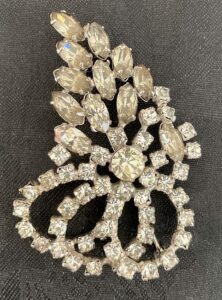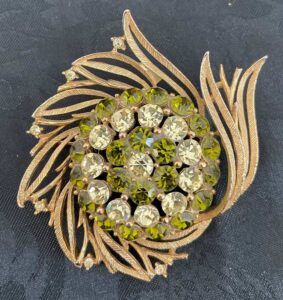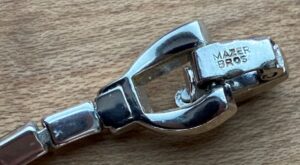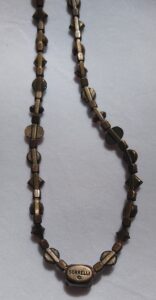
by Dr. Lori Verderame

How to tell fake costume jewelry is harder than you might think. In order to make the process easier, I have given a primer or list of what to look for and how to spot a fake. Costume jewelry fakes were introduced into the market in the late 20th century and have continued to be produced and presented in the market as true and authentic examples of costume jewelry pieces for decades, ever since. When it comes to costume jewelry, most people realize that there are many manufacturers that make impressive and high-quality real pieces including brooches, pins, necklaces, bracelets, rings, anklets, etc. Read more ways to identify costume jewelry fakes in another article.
Of course, even the best pieces of costume jewelry will not bring the kind of high values that fine jewelry in gold, sterling silver, and platinum with precious gemstones will command, but costume jewelry is still highly desirable on today’s market. Many collectors prefer costume jewelry pieces to real or fine jewelry pieces because of the design, color, and ease of use that they offer. When compared to fine jewelry, many people prefer costume jewelry for its lower cost and ease of replacement if lost.
Seasoned and well-informed costume jewelry collectors recognize good quality examples by firms like Eisenberg, Trifari, Coro, Monet, etc. and they know how to spot a fake or fraud piece of costume jewelry too. Here’s what to look for and avoid when it comes to costume jewelry.
What to Look For
Always look for quality and well-made materials when shopping for costume jewelry. Some of the ways how to tell fake costume jewelry is to know about the history of this popular collecting category. History teaches us that early 1900s pieces of costume jewelry were more commonly hand made. In the early 1900s, until the World War II era, the majority of pieces of costume jewelry were the result of many die-struck elements that were soldered together to make a design. Look for the work of an artisan and compare that piece to the work made by a machine. When a piece of jewelry is die-struck, that means that pressure is used to push metal into a mold. The mold is die struck. For instance, a precious metal like gold can be die-struck to make a piece of jewelry with a male hub die form and a female master die form.
The easy way to spot real costume jewelry from fake costume jewelry is to look for the difference between a handmade piece that are typically the real thing and a mass produced, machine made piece that can easily be a fake.
Spotting Fake Marks
Most people think if a piece of costume jewelry is marked, then it must be a real piece and it must be made by that maker. I am sorry to say this but that is vary far from the truth. Just because something is marked, that doesn’t make it authentic. Here are some ways to spot a fake and a real mark on costume jewelry.
Marks and markings are the easiest way to tell if a piece is fake, phony, or fraudulent. A rule of thumb for most pieces of costume jewelry is that authentically marked pieces are commonly die-stamped into the metal on a piece of costume jewelry. A cast mark, commonly used on fake pieces, are not sharp. Die-stamped maker’s marks are typically sharp, clean and easy to recognize as the real deal. If your piece of costume jewelry has a box or a bar around the maker’s name or maker’s logo or mark, then you most probably have a fake piece of costume jewelry. If a maker’s name is set into a bar or a rectangular block on the back of a piece of costume jewelry, odds are it’s a fake. Fake names are typically cast or molded onto a piece of costume jewelry. On the other hand, authentic pieces of costume jewelry more often than not have their maker’s or studio designer’s name stamped into the piece. Cast names are typically fake and they lack the sharpness or crisp quality of a realistically die-stamped costume jewelry maker’s name.
Marks through the ages. While it doesn’t make the issue of identification easy, many costume jewelry manufacturers change the look of their mark over time. Some add information to an existing maker’s mark to introduce a new line or to highlight a new style of costume jewelry design. Some marks are used differently during a particular time period. Remember that marks on a piece of costume jewelry is only one indicator of age. Don’t rely solely on the maker’s mark to identify the age of a piece. Learn about specific materials and styles that were popular in a certain time period and that information will help you identify the valuable and real pieces of costume jewelry.
Tools and Helpful Hints
One of the best tools at your disposal on how to tell fake costume jewelry is the all-important black light. See my recommendations for black lights. If you don’t know how a black light works, it is an interesting tool that many collectors use to see what cannot be seen by the naked eye. Black lights give off a harmless yet high energy ultraviolet light which is invisible to the naked eye. Some fluorescent substances will absorb the ultraviolet light and then re-emit that light at a different wavelength. This change makes the light visible showing a glowing appearance. When you use a black light, it will show various changes made to the piece of costume jewelry. A black light will show if a maker’s tag is glued on or molded onto the piece of costume jewelry, too.
Mountings, Settings, and Prongs
Three things that are vital to a piece of costume jewelry will also help you keep the real thing and dump the fake. Those three elements are important: Mountings, Settings, and Prongs. They tell the real story with a quick look. One of the best ways to spot a costume jewelry fake is to examine the mountings, settings, and prongs.
Early 20th Century prongs used on costume jewelry were short, thin, and slender when compared to the wide, thick, and long pieces that were introduced on fake pieces of costume jeweler in the late 20th Century. Why are the new and fake pieces wider, thicker, and longer? These new pieces used on fake pieces of costume jewelry were produced by a mold process and are larger so it was easier to divorce the finished piece from the mold.
When it comes to prongs on fake pieces of costume jewelry, many of them reach over the top of the stone that it is trying to secure in the setting. If a prong is not bent over the stone, then you probably have a fake, too. If a prong exists on a setting for a piece of costume jewelry then it exists to do an important job—to secure the gemstone in the bracelet, necklace, brooch, etc. If a prong is not doing a job, then it probably isn’t working. If a stone is not bent, then it is not doing its job. If a stone is glued down, and you can see this using your black light, then it probably is a fake piece of costume jewelry. Glue is difficult to detect by a human eye but it will fluoresce under black light. If a prong is too long, it will obscure or hide the stone and that is not what real costume jewelry designers want. The length of a prong on a piece of costume jewelry is notable too. For instance, the length of a prong must be just long enough to secure the stone in its desired location. Modern copies or fakes usually have long, wide, and thick prongs. Look out for these traits on a piece of costume jewelry.
Preview the Prongs

Mountings are another important tell tale sign when trying to spot a fake piece of costume jewelry. For instance, individual mountings are often soldered onto the main part of a real costume jewelry piece made by a major manufacturer or designer. Wires and soldering are used in tandem on good pieces of costume jewelry. Actually, fake costume jewelry pieces use more metal in a somewhat sloppy, heavy handed manner than real costume jewelry pieces by important manufacturers and designers. In most cases, authentic costume jewelry pieces are soldered together.
Fakes in the Market
Of course, costume jewelry fakes, when discovered, will command a lower price and will be evaluated at a lower retail appraised value than their real or fine jewelry counterparts. The market will not support fake costume jewelry pieces when compared to true costume jewelry items. The good thing that is happening is the abundance of costume jewelry pieces available in the market now. The many pieces in the market now are giving collectors so many opportunities to compare and contrast costume jewelry pieces that are real and those that are fake. New tools, expert tips, and examination of actual pieces are now offering opportunities to learn how to spot a fake and tell the difference between the good, the bad, and the ugly. Read more ways to identify costume jewelry fakes in another article.
Watch videos on my YouTube channel where I show you how to tell fake costume jewelry. I can appraise your jewelry pieces from photos or you can show me your pieces during a video call.





